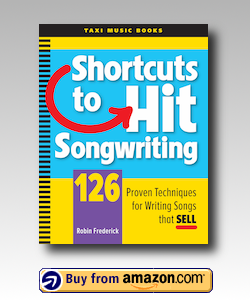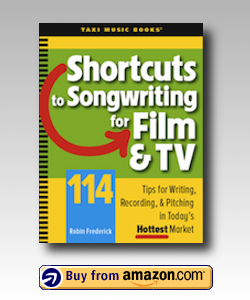‣ Study Today's Hit Songs!
You can easily keep up to date with the successful techniques of today's top songwriters by studying current hits. It's an essential skill if you want to write songs that are competitive and expressive, and it's a lot of fun! Hit songs can be full of surprises and can inspire you to try new ideas in your own songs.
For those of you who have my books - "Shortcuts to Hit Songwriting" and 'Shortcuts to Songwriting for Film & TV" - I've referred to Shortcuts that can tell you more about the ideas discussed here. Both books are available at Amazon.com.
"FALLIN' FOR YOU" - COLBIE CAILLAT(Colbie Caillat & Richard Nowels)
There are so many influences from Fleetwood Mac's golden hits of the mid-1970s that it's impossible to listen to this song without being reminded of those timeless, unforgettable hits. It's a perfect example of how to take a style that had enormous appeal in an earlier decade and give it a fresh twist that makes it seem new again. |
"YOU BELONG WITH ME" - TAYLOR SWIFT(Liz Rose & Taylor Swift)
STRUCTURE |
"COME ON GET HIGHER" - MATT NATHANSON(Matt Nathanson, Mark Weinberg)
This beautifully written hit song by Matt Nathanson has had over a million and a half downloads at iTunes. Nathanson's songs are regularly featured in TV shows like One Tree Hill, The Vampire Diaries, and NCIS. He writes songs that come from the heart and connect with listeners by being both totally believable and completely entertaining. |
"SOUNDS LIKE LIFE TO ME" - DARRYL WORLEY(Darryl Worley, Wynn Varble, Phil O'Donnell)
This hit song has a traditional-style Country lyric and a melody that also features many traditional elements. It's a co-write with the artist which means, at least in this case, that it doesn't have to be the killer, stand-alone single that publishers and record labels demand from songwriters pitching songs to an artist. Still, there's song craft that's worth studying and it's an easy song to learn. |
"SOUND OF MADNESS" - SHINEDOWN(Brent Smith, Dave Bassett) Buy this song at iTunes.
There are many hard-rockin' bands out there working the club circuit. They'd like to get a record deal but can't seem to interest a label. Their fans love them, so why won't the the music industry sign them up? |
"WAKING UP IN VEGAS" - KATY PERRY(Andreas Carlsson, Katy Perry, Desmond Child)
What a fun piece of Pop candy this is! A fresh, character-driven lyric and a catchy, singable chorus melody. Like an ice cream cone, it probably won't stick around very long but it's tasty while it lasts! Here's how they did it... |
"CRUSH" - DAVID ARCHULETA(Jess Cates / David Hodges / Emanuel Kiriakou)
THEME |
"ONE IN EVERY CROWD" - MONTGOMERY GENTRY(Ira Dean / Kim Tribble / Eddie Montgomery)
Talk about an irresistible bunch of fun! This song has listener appeal from the first line to the last and here's how they do it... |
"IF I WERE A BOY" - BEYONCÉ(Toby Gad / Britney Carlson / Beyonce Knowles)
STRUCTURE |
"GOTTA BE SOMEBODY" - NICKELBACK(Chad Kroeger)
Chad Kroeger of Nickelback is a songwriting ace. When he aims for a hit single, he doesn't miss! He knows how to catch the listener's attention and hold it, especially with his melody. You can use many of the same tricks that Chad uses -- they're not difficult at all! Remember, I'm not suggesting that you try to sound like Nickelback, just blend some of these techniques with your own sound to create a unique, distinctive song style with plenty of listener appeal. |
"HERE" - RASCAL FLATTS
The song structure is the one that's used in so many of today's hit singles: Verse / Pre-chorus / Chorus / Verse / Pre-chorus / Chorus / Bridge / Chorus. The chorus begins with the line "And I wouldn't change a thing..." and ends with an emotional payoff in the final phrase "here, right here." Notice how this phrase is set up with a short pause that gives it more weight and draws attention to it (Shortcut #96). The pre-choruses both begin with the phrase, "I know now..." The bridge flows right out of the second chorus so it's a little hard to spot. It actually starts with the last word of the chorus (and the title of the song): "here... in a love I never thought I'd get to." The word "here" does double duty as the end of the chorus and beginning of the bridge, a great way to keep the song flowing forward and pull the listener right into the bridge. Try this technique in one of your own songs as a transition between sections. LYRICS This lyric is a good example of taking a familiar theme - Love - and approaching it from an unusual angle. Actually, it reminds me of another Rascal Flatts hit, "Bless the Broken Road." The message is: Love is worth the struggle it takes to find and appreciate it. Here, the struggle is treated in more depth and detail than in "Bless the Broken Road." The first verse uses a group of poetic images - "in and out of buildings" "behind windows, walls, and doors" - to suggest someone who has essentially kept himself at a distance from others. And sure enough, the lines that follow support that idea; the singer didn't stay in any relationship for very long. This is an effective use of the family of associations that come with certain images (Shortcut #58). The chorus lyric builds intensity in the first four lines, culminating in the singer stating that he would relive a broken heart "on the day that it was breaking." Raising the stakes over a series of lines is a creative way to draw your listeners into your song. Every line in the chorus includes an image or action word. By using visual and physical words, the song avoids making abstract statements about how the singer feels. Abstract statements leave listeners out in the cold. Get them involved in your song by giving them words they can see and feel (Shortcuts #57 and #62). The rhymes are simple and don't call attention to themselves. This is a conversational lyric, giving the impression that the singer is revealing personal feelings in an honest way, as if he just thought of what he's saying. Keeping the rhymes simple and unobtrusive adds to the believability of the lyric. MELODY This melody is another beauty from Jeffrey Steele, a master class in contemporary Country melody writing. Here are some things to listen for: The verse melody consists of two very short phrases, followed by a long phrase. This pattern is then repeated with a little variation to keep it interesting. Notice how the long third line runs right up to the beginning of Line 4 ("...walls and doors / And I thought I found it...") Use this idea to add forward momentum to your melody, pulling listeners into the next line just when they expect to take a little rest! The pre-chorus melody begins with a three smooth, held-out notes ("I know now..."), very different from the chatty verse melody, creating contrast that gets noticed. This is followed by a couple of repeated melodic phrases ("the place that I... Was you right here..."). Repetition like this creates tension, dynamically building the listener's sense of anticipation going into the chorus. And the chorus does not disappoint... The chorus opens with a big interval jump. It's an octave from the end of the pre-chorus to "wouldn't change a thing" in the first line of the chorus! A jump like this grabs the listener's attention and makes it clear the song has moved to a new emotional level (Shortcut #93). Notice that the chorus melody, like the verse melody, also features two short melodic phrases followed by a longer one, then repeats that pattern before arriving at the final payoff line. This is a melodic pattern that's very appealing and memorable. Try writing a chorus melody of your own based on this pattern (Shortcut #90). There are many more useable, exciting techniques in this song that you can apply to your own melodies and lyrics. It's well worth studying if you're interested in writing for today's hot Contemporary Country market. Use it as a "ghost song" to practice sharpening your skills in this major, hit-driven genre. For more on "ghost songs," read my article on this site: "Notes On Songwriting." Copyright 2009 Robin Frederick |
"I'M YOURS" - JASON MRAZ
Jason Mraz's No. 1 Adult Contemporary hit, "I'm Yours," is a great example of an upbeat, happy song that still manages to convey depth in the lyrics and unexpected twists in the melody, keeping listeners involved from beginning to end. SONG STRUCTURE The song has an interesting structure: Verse / Short Chorus / Verse / Chorus / Bridge / Verse / Chorus. The final chorus is a duet with the background singers singing the chorus melody and Mraz repeating a verse. The chorus always begins with the line "I won't hesitate no more, no more" and ends with the title in the payoff line, "I'm yours." The first time we hear the chorus, he sings just the opening line and payoff line, dishing up the key lines from the chorus as a kind of appetizer. (Shortcuts #25, #50, and #119) MELODY Mraz does a neat trick with this melody. The note range in the verse and chorus is essentially the same. And in both verse and chorus the melody has a lot of small jumps - leaping over 2 or 3 notes on its way up or down the scale. So much 'same-ness' between verse and chorus could be the kiss of death. Listeners crave contrast in the melody - it grabs attention and helps to give them a clear road map through the song. (Oh, we're in THAT section!) Jason Mraz uses a strong shift in the RHYTHM OF THE MELODY to provide that contrast. This is a great example of a technique you might want to try. To find out how he does it... Count along with the underlying rhythm of the song throughout the verse and chorus. (Count 1 - 2 - 3 - 4 for each bar.) Notice how in the verses, Mraz uses two notes (and two word syllables) on almost every beat. When you get to the chorus, it changes! AHA!!! CONTRAST! In the chorus there's only one note (and one syllable) per beat! "I - won't - hes - i - tate - no - more, etc. There's no mistaking the verse for the chorus. They're very different in their melodic rhythm patterns. Try playing with this unusual technique in a song of your own! (Shortcuts #22, #74, #88, and #94) LYRICS The catchy melody is really the star of the show in this song while Mraz has fun with the words. The busy, playful lyric creates a sense of whimsy and surprise, using nonsense words and baby-talk like "bestest" and "scootch." The first verse is solid and well developed. It's obviously boy-meets-love and there's plenty of fun. ("I tried to be chill but you're so hot that I melted.") The second verse opens up the theme to include the whole world. Here the singer is doing just what lovers do - imagining the entire world feels like they do. Developing your lyric along broad, general lines like this can be risky. Listeners may wonder what happened to the personal love story that was introduced in the first verse? But Mraz saves it by using a rich store of language with surprising and unexpected undertones. A line like "It's our God-forsaken right to be loved" bounces right along with the happy melody while introducing the phrase "God-forsaken" with it's dark associations. (Reminds me of some of Randy Newman's lyrics!) The end of that line and an earlier line both reference the Beatles "All You Need Is Love" with all the associations listeners have with that song! He's having so much fun that we do, too! PRODUCTION The reggae beat on guitar and keys mixed with a Modern Pop drum track and tons of compression on the vocal give the track a contemporary flavor while retaining the fun and familiarity of classic reggae. A good mix of loose and tight in the musical performances gives the whole track an authentic, party-time feel. This is tough to do so be careful if you're going to try something like this. Get the best players you can or rehearse your band hard, then relax for the actual recording session. Copyright 2009 Robin Frederick |
More hit songs...
Over her 35 years in the music industry, Robin Frederick has written more than 500 songs for television, records, theater, and audio products. She is a former Director of A&R for Rhino Records , Executive Producer of 60 albums, and the author of "Shortcuts to Hit Songwriting." Robin currently oversees the A&R Team for TAXI, the world's leading independent A&R company.
Robin's books are used to teach songwriting at top universities and schools in the U.S. They're fun to read and filled with practical, real world information. Buy them at Amazon.com...
Shortcuts to Hit Songwriting
Shortcuts to Songwriting for Film & TV






